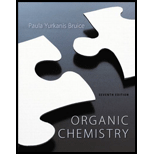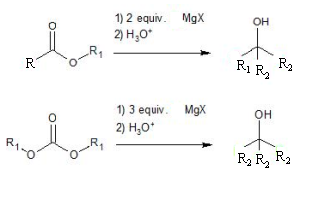
Organic Chemistry; Modified MasteringChemistry with Pearson eText -- ValuePack Access Card; Study Guide and Student Solutions Manual for Organic Chemistry, Books a la Carte Edition (7th Edition)
7th Edition
ISBN: 9780134240152
Author: Paula Yurkanis Bruice
Publisher: PEARSON
expand_more
expand_more
format_list_bulleted
Concept explainers
Question
Chapter 17.4, Problem 9P
Interpretation Introduction
Interpretation:
It should be identified that the given secondary alcohols which can be prepared by the formic acid with excess of Grignard reagent.
Concept introduction:
Reactions of Esters and Acyl Chlorides with Grignard reagents:
Ester and acyl chlorides undergoes Nucleophilic acyl substitution and Nucleophilic addition reaction when those are react with Grignard reagent.
Ester react with Grignard reagent

Expert Solution & Answer
Want to see the full answer?
Check out a sample textbook solution
Students have asked these similar questions
Which of the following has the largest standard molar entropy, S° (298.15 K)
He
H2
NaCl
KBr
Hg
Which of the following is true for a particular reaction if ∆G° is -40.0 kJ/mol at 290 K and –20.0 kJ/mol at 390 K?
What is the major product of the following reaction?
O
O
OH
OH
1. BH
2. H₂O₂, NaOH
OH
OH
Chapter 17 Solutions
Organic Chemistry; Modified MasteringChemistry with Pearson eText -- ValuePack Access Card; Study Guide and Student Solutions Manual for Organic Chemistry, Books a la Carte Edition (7th Edition)
Ch. 17.1 - Prob. 1PCh. 17.1 - Give two names for each of the following:Ch. 17.1 - Name the following:Ch. 17.2 - Prob. 4PCh. 17.4 - What products are formed when the following...Ch. 17.4 - We saw on the previous page that...Ch. 17.4 - a. How many stereoisomers are obtained from the...Ch. 17.4 - Prob. 9PCh. 17.4 - Write the mechanism for the reaction of acetyl...Ch. 17.4 - Prob. 11P
Ch. 17.4 - Show how the following compounds can be...Ch. 17.5 - Prob. 13PCh. 17.5 - Prob. 14PCh. 17.6 - In the mechanism for cyanohydrin formation, why is...Ch. 17.6 - Prob. 16PCh. 17.6 - Prob. 17PCh. 17.6 - Show two ways to convert an alkyl halide into a...Ch. 17.7 - Prob. 20PCh. 17.7 - Prob. 21PCh. 17.7 - Prob. 22PCh. 17.7 - Prob. 23PCh. 17.8 - Prob. 24PCh. 17.9 - What reducing agents should be used to obtain the...Ch. 17.9 - Prob. 26PCh. 17.9 - Prob. 27PCh. 17.10 - Prob. 28PCh. 17.10 - Prob. 29PCh. 17.10 - Prob. 30PCh. 17.10 - The pKa of protonated acetone is about 7.5. and...Ch. 17.10 - Prob. 32PCh. 17.10 - Prob. 33PCh. 17.10 - Prob. 34PCh. 17.10 - Excess ammonia must be used when a primary amine...Ch. 17.10 - The compounds commonly known as amino acids are...Ch. 17.11 - Hydration of an aldehyde is also catalyzed by...Ch. 17.11 - Which ketone forms the most hydrate in an aqueous...Ch. 17.11 - When trichloroacetaldehyde is dissolved in water,...Ch. 17.12 - Which of the following are a. hermiacetals? b....Ch. 17.12 - Prob. 41PCh. 17.12 - Explain why an acetal can be isolated but most...Ch. 17.13 - Prob. 43PCh. 17.13 - Prob. 44PCh. 17.13 - What products would be formed from the proceedings...Ch. 17.13 - a. In a six-step synthesis, what is the yield of...Ch. 17.13 - Show how each of the following compounds could be...Ch. 17.15 - Prob. 48PCh. 17.17 - Prob. 50PCh. 17.18 - Prob. 51PCh. 17.19 - Prob. 52PCh. 17 - Draw the structure for each of the following: a....Ch. 17 - Prob. 54PCh. 17 - Prob. 55PCh. 17 - a. Show the reagents required to form the primary...Ch. 17 - Prob. 57PCh. 17 - Using cyclohexanone as the starting material,...Ch. 17 - Prob. 59PCh. 17 - 60. Show how each of the following compounds could...Ch. 17 - Fill in the boxes:Ch. 17 - Prob. 62PCh. 17 - Identify A through O:Ch. 17 - Prob. 64PCh. 17 - Prob. 65PCh. 17 - Prob. 66PCh. 17 - How many signals would the product of the...Ch. 17 - Prob. 68PCh. 17 - Prob. 69PCh. 17 - Prob. 70PCh. 17 - Prob. 71PCh. 17 - Prob. 72PCh. 17 - Prob. 73PCh. 17 - Prob. 74PCh. 17 - Prob. 75PCh. 17 - Prob. 76PCh. 17 - Prob. 77PCh. 17 - A compound gives the following IR spectrum. Upon...Ch. 17 - a. Propose a mechanism for the following reaction:...Ch. 17 - Prob. 80PCh. 17 - Prob. 81PCh. 17 - Prob. 82PCh. 17 - Prob. 83PCh. 17 - Prob. 84PCh. 17 - In the presence of an acid catalyst, acetaldehyde...Ch. 17 - Prob. 86PCh. 17 - Prob. 87PCh. 17 - Prob. 88PCh. 17 - A compound reacts with methylmagnesium bromide...Ch. 17 - Show how each of the following compounds can be...Ch. 17 - Prob. 91PCh. 17 - Prob. 92PCh. 17 - The pKa values of the carboxylic acid groups of...Ch. 17 - The Baylis-Hillman reaction is a DABCO...Ch. 17 - Prob. 95PCh. 17 - Prob. 96P
Knowledge Booster
Learn more about
Need a deep-dive on the concept behind this application? Look no further. Learn more about this topic, chemistry and related others by exploring similar questions and additional content below.Similar questions
- How many products are possible from the following reaction? Do not take into account stereoisomers. 01 04 03 O O O O 02 CH H₂SO4 heatarrow_forwardplease helparrow_forwardChoose the major product of the reaction with correct regio- and stereochemistry. Br2 H₂O O "Br Br & O 'Br OH Br 吡 O OH OH Br "OH Brarrow_forward
- Select the major product of the following reaction. & Br (CH)CONa (CH₂),COH 0 OC(CH) O &arrow_forwardDraw the products of the hydrolysis reaction between the ester molecule and water. Determine the products of the following reaction.arrow_forwardWhat is the unsaturation number for compounds with the formula C₂H₁₂Cl₂? O õ õ o o 4 3arrow_forward
- Indicate the product obtained (formula). F3C. CF3 Br NH2 NH OMe K2CO3, DABCO, DMFarrow_forwardWhat are the missing intermediates 1, 2, and 3? Please include a detailed explanation explaining the steps of malonic ester synthesis. Please include drawings of the intermediates and how they occur.arrow_forwardThe following intermediates are to proceed by acetoacetic ester synthesis. What are intermediates 1 and 2 plus the final product 3? Please include a detailed explanation and drawings of the intermediates and how they occurred.arrow_forward
arrow_back_ios
SEE MORE QUESTIONS
arrow_forward_ios
Recommended textbooks for you
 Organic ChemistryChemistryISBN:9781305580350Author:William H. Brown, Brent L. Iverson, Eric Anslyn, Christopher S. FootePublisher:Cengage Learning
Organic ChemistryChemistryISBN:9781305580350Author:William H. Brown, Brent L. Iverson, Eric Anslyn, Christopher S. FootePublisher:Cengage Learning Chemistry for Today: General, Organic, and Bioche...ChemistryISBN:9781305960060Author:Spencer L. Seager, Michael R. Slabaugh, Maren S. HansenPublisher:Cengage Learning
Chemistry for Today: General, Organic, and Bioche...ChemistryISBN:9781305960060Author:Spencer L. Seager, Michael R. Slabaugh, Maren S. HansenPublisher:Cengage Learning
 Introductory Chemistry: A FoundationChemistryISBN:9781337399425Author:Steven S. Zumdahl, Donald J. DeCostePublisher:Cengage Learning
Introductory Chemistry: A FoundationChemistryISBN:9781337399425Author:Steven S. Zumdahl, Donald J. DeCostePublisher:Cengage Learning

Organic Chemistry
Chemistry
ISBN:9781305580350
Author:William H. Brown, Brent L. Iverson, Eric Anslyn, Christopher S. Foote
Publisher:Cengage Learning

Chemistry for Today: General, Organic, and Bioche...
Chemistry
ISBN:9781305960060
Author:Spencer L. Seager, Michael R. Slabaugh, Maren S. Hansen
Publisher:Cengage Learning


Introductory Chemistry: A Foundation
Chemistry
ISBN:9781337399425
Author:Steven S. Zumdahl, Donald J. DeCoste
Publisher:Cengage Learning